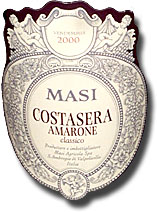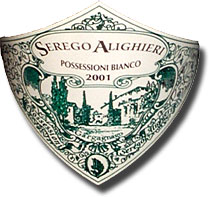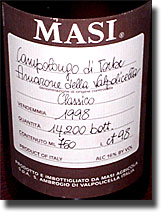|


ecently, I had the opportunity to sit in
on a mini - seminar, courtesy of Dan Schwarz,
Michigan Area Manager for Remy Amerique Inc., (New York, NY),
importers of the wines of
Masi and
Alighieri.
The seminar was to better inform the regional wine trade
community as to the unique character of the wines of Veneto, Italy,
as produced by those two historic wineries, and was conducted by Masi
Marketing Manager, Lorenzo Boscaini.
The Boscaini family has operated
Masi for six generations, with company president
Sandro Boscaini currently managing the overall operation,
and brother Sergio (chief enologist)
and cousins Roberto (logistics
manager) and Dario (viticultural)
holding leadership positions in the Masi Technical Group, which
is responsible for research and new developments. Their mission is to
produce premium modern wines using mainly indigenous varietals and
vinification methods.
 The
name "Masi" comes from Vaio dei
Masi, the first vineyard acquired by the family in the late 18th
century. Since that time, the winery has grown through careful selection
and acquisition of quality vineyards, centered mainly in the classico
zones of Valpolicella, Bardolino and Soave. Masi is
also in partnership with Count Serego Alighieri,
descendent of the poet Dante Alighieri,
whose family has owned prestigious vineyards and cellars in
Gargagnago since 1353. In the last ten years, Masi has spread to
other viticultural regions of Veneto, as well as Argentina, but
this seminar dealt exclusively with wines of Valpolicella, with a lone
exception. Lorenzo started us off with a couple of whites. The
name "Masi" comes from Vaio dei
Masi, the first vineyard acquired by the family in the late 18th
century. Since that time, the winery has grown through careful selection
and acquisition of quality vineyards, centered mainly in the classico
zones of Valpolicella, Bardolino and Soave. Masi is
also in partnership with Count Serego Alighieri,
descendent of the poet Dante Alighieri,
whose family has owned prestigious vineyards and cellars in
Gargagnago since 1353. In the last ten years, Masi has spread to
other viticultural regions of Veneto, as well as Argentina, but
this seminar dealt exclusively with wines of Valpolicella, with a lone
exception. Lorenzo started us off with a couple of whites.
2003 Masi Masianco I.G.T., 75% Pinot Grigio delle Venezie, 25%
Verduzzo, $13.99, 13% alc.: This pale to medium straw colored "Supervetian"
is made of fruit sourced from selected vineyards at Castions de Strada,
Friuli; it exudes a fragrant green apple - pear bouquet, with just a
hint of minerality. Fairly rich and round (more so than your average
pinot grigio), the flavors echo and expand on the promise of the
aromatics, with a creamy quality, good acidity and a finish that lingers
nicely. The pinot grigio is vinified immediately after harvesting in
late August, while the verduzzo spends an extra month on the vine and
another three weeks on bamboo racks to dry. According to Lorenzo, the
pinot grigio gives the wine its freshness, while the verduzzo gives
structure, complexity, body and a velvety texture. Very food friendly
and appealing, this will make an excellent "house white" at Gang Central
next summer.
 2001
Serego Alighieri Possessioni Bianco del Veneto I.G.T., 70% Garganega,
30% Sauvignon Blanc, 13.99, 12.5% alc.: Medium straw to pale gold in
color, this is the only white produced in Valpolicella. It features a
chalky green apple nose, with flavors to match; it's rich and round on
the palate, with crisp acidity, a decent finish and a distinct mineral
component. The sauvignon sees three months in barrique, lending a
noticeable influence to the aromatics. A wine that serves well as an
aperitif, it's also food friendly, and has the acidity for at least
short term aging. With a decidedly different personality from the
Masianco, this is a pleasant and enjoyable glass of bianco. 2001
Serego Alighieri Possessioni Bianco del Veneto I.G.T., 70% Garganega,
30% Sauvignon Blanc, 13.99, 12.5% alc.: Medium straw to pale gold in
color, this is the only white produced in Valpolicella. It features a
chalky green apple nose, with flavors to match; it's rich and round on
the palate, with crisp acidity, a decent finish and a distinct mineral
component. The sauvignon sees three months in barrique, lending a
noticeable influence to the aromatics. A wine that serves well as an
aperitif, it's also food friendly, and has the acidity for at least
short term aging. With a decidedly different personality from the
Masianco, this is a pleasant and enjoyable glass of bianco.
2002 Masi Bonacosta Valpolicella Classico D.O.C., 70% Corvina, 25%
Rondinella, 5% Molinara, $10.99, 12% alc.: Valpolicella means
"valley of many cellars" in Italian, and as a wine producing region,
extends back to the time of the Romans. Bonacosta means "good slope",
and refers to the foot of the same hillsides where the Amarone grapes
are grown; "Classico" indicates that the fruit is sourced only from the
original appellation. Ruby garnet in color, this wine shows flavors and
aromas of black and dried cherries, shaded with a little licorice,
earth and underbrush. Medium to medium full bodied, with low tannins,
good acidity and a decent finish, this is easy to drink, making for an
ideal red quaffer. Lorenzo tells us that the cherry character is typical
of the corvina component, and while it apparently has the potential to
age for five or six years, it's appealing for its fresh, bright fruit
right now.
2001 Masi Campofiorin Ripasso
® Nectar Angelorum Hominibus Rosso
del Veronese I.G.T., 70% Corvina, 25% Rondinella, 5% Molinara, $14.99,
13% alc.: This ruby dark garnet is Masi's expression of the ancient
vinification method known as refermentation, for which they coined the
name "Ripasso". Using a technique in which the basic wine undergoes a
second fermentation on the residual pomace of the dried grapes used to
make Amarone, the resulting "Ripasso" gains increased color, alcohol,
complexity, structure and fruit. Essentially a "baby Amarone," this is
aged mostly in 3,000 liter barrels, along with some 600 liter barrels,
in order to avoid excessive wood in the flavor profile. Tasting this on
the heels of the Valpolicella certainly emphasizes the point, as the
wine is bigger, being medium full bodied, with deeper, darker flavors
and aromas of tarry black cherry, along with some raisiny notes.
Moderately tannic, with good acidity, and rich and round in the mouth,
this is the kind of wine that I can definitely cozy up to, and it shows
good prospects for development with some time in the bottle.
1998 Masi Brolo de Campofiorin Rosso del Veronese I.G.T., 75 - 80%
Corvina, 20 - 25% Rondinella, $27.99, 13.5% alc.: The term "Brolo"
corresponds to the French term "clos," and refers to vineyards
surrounded by stone walls, in this case, located at Valgatara di Marano,
in the heart of Valpolicella Classico. A special selection of
Campofiorin, this contains no molinara, resulting in less acidity and
more complexity. After refermentation, the wine is aged in mostly
Slavonian 600 liter oak barrels, which impart more delicate nuances than
French oak, although some Allier oak is also employed. The dark garnet
colored wine gives up a rich, almost floral cherry and black cherry
bouquet, accented with notes of coffee, chocolate and earth; these
follow through on the palate with medium full to full body, good
structure and good prospects for aging, at least three to five years
worth. Definitely a step up from the previous model, and even more to
this taster's liking, this is very nice indeed.
2000 Masi Costasera Amarone della Valpolicella - Classico D.O.C., 70%
Corvina, 25% Rondinella, 5% Molinara, $38.99, 15% alc.: Ah,
appassimento, the method of drying the best grape clusters (grown only
on hillsides facing southwest) in wooden boxes or on bamboo racks for 36
- 48 hours in controlled atmosphere rooms, and then in large rooms in
old farmhouses with large openings or windows to allow the free flow of
air until about the middle of January. In that time, the grapes lose 35
- 40% of their weight, and develop higher concentrations of sugar and
flavor, with the corvina being attacked by botrytis, or "noble rot."
After a delicate pressing, the wine is fermented in large Slavonian oak
barrels for 50 days, followed by successive rackings and transfers into
30 - 40 hectoliter barrels (three to four months) and large oak and
smaller 600 liter Slavonian and Allier oak for another 20 - 30 months.
The whole process provides a contrast between the dry character of the
wine and an illusion of sweetness; some glycerine remains, but the
sugars have been fermented out.
The wine itself is dark garnet in color, and exudes lovely aromatics of
deep, dark black cherry, with notes of raisins and a hint of coffee in
the background. These impressions carry over into the full bodied
flavors, with some added earth and underbrush, good structure and a long
finish. This is a great value, with excellent aging potential,
especially for those who might otherwise balk at more expensive
bottlings from these (and other) producers.
 1998
Masi Campolongo di Torbe Amarone D.O.C., 70% Corvina, 25% Rondinella, 5%
Molinara, $98, 16% alc.: Essentially a 1st Cru Amarone from a
vineyard at the top of the hill above the fogline, this undergoes
the same process as the Costasera through pressing and the initial 50
day fermentation in large Slavonian oak barrels; then the wine is
transferred to 20 - 50 hectoliter old oak barrels for secondary and
malolactic fermentation, followed by three to four years in large old
oak and 600 liter Allier barrels. The wine is sweet, rich and
decadent, showing a deep, dark garnet color and exuding aromas that seem
to suggest that it's fortified, but such is not the case. With flavors
and aromas of cherry, black cherry, raisin, earth and a note of almond,
this is like velvet on the palate, despite the obviously formidable
structure. A wine to meditate upon, one with 35 - 40 years of aging
potential. 1998
Masi Campolongo di Torbe Amarone D.O.C., 70% Corvina, 25% Rondinella, 5%
Molinara, $98, 16% alc.: Essentially a 1st Cru Amarone from a
vineyard at the top of the hill above the fogline, this undergoes
the same process as the Costasera through pressing and the initial 50
day fermentation in large Slavonian oak barrels; then the wine is
transferred to 20 - 50 hectoliter old oak barrels for secondary and
malolactic fermentation, followed by three to four years in large old
oak and 600 liter Allier barrels. The wine is sweet, rich and
decadent, showing a deep, dark garnet color and exuding aromas that seem
to suggest that it's fortified, but such is not the case. With flavors
and aromas of cherry, black cherry, raisin, earth and a note of almond,
this is like velvet on the palate, despite the obviously formidable
structure. A wine to meditate upon, one with 35 - 40 years of aging
potential.
And with that, the seminar was concluded, but not the tasting. Dan
Schwarz had brought along a couple of bottles of Serego Alighieri
Vaio Armaron Amarone della Valpolicella that we last tasted with him
a year ago, and he thought this would be a good opportunity to see how
they were coming along. The Vaio Armaron vineyard in Gargagnago
lies 180 - 265 meters above sea level, with southwest exposure; Vaio
means "little valley." After drying and gentle pressing, the grapes
ferment for about 45 - 50 days in large Slavonian oak barrels, after
which, the wine is transferred to old six to twenty hectoliter barrels
(some made of cherry wood), where it ages for four to five years. We
tasted from two successive vintages.
1996 Serego Alighieri Vaio Armaron Amarone della Valpolicella D.O.C.,
65% Corvina, 20% Rondinella, 15% Molinara, $56.99, 15.5% alc.: Dark
garnet in color, with sweet, rich black cherry and raisin flavors and
aromas shaded with hints of chocolate and earth; the acidity is more
apparent than the tannins at this point, which Dan attributes to "a
leaner vintage." Rich, concentrated and delicious, this is quite
raisined, in a good way, and more so than last year. Don't be in any
hurry to drink this, as it will continue to develop for many years.
1997 Serego Alighieri Vaio Armaron Amarone della Valpolicella D.O.C.,
65% Corvina, 20% Rondinella, 15% Molinara, $56.99, 15.5% alc.: An
inky, opaque garnet, this is even more raisined on the nose than the
'96, with that "fortified" quality. It's showing less acidity, more body
and a more voluptuous character on the palate than the previous
selection, with a nice note of chocolate over raisined black cherry. The
earthy tannins are more apparent than in the '96, and in the mouth, it's
thick, yet velvety. Marvelous stuff, but like its predecessor, don't
feel the need to drink it any time soon. Unless you want to, of
course...
 Lorenzo
Boscaini (right) projects an infectious enthusiasm when speaking
on the wines of Masi and Alighieri, and indeed, the wines themselves
range from very good to great in quality, with not one
disappointment in the lineup tasted on this occasion. I came away with a
much greater appreciation for the wines of Veneto, and in particular, Valpolicella, and
will most certainly investigate them further. Many thanks to
Lorenzo for his excellent presentation, and to Dan Schwarz for
his generosity in inviting me to this informative and enjoyable event. Lorenzo
Boscaini (right) projects an infectious enthusiasm when speaking
on the wines of Masi and Alighieri, and indeed, the wines themselves
range from very good to great in quality, with not one
disappointment in the lineup tasted on this occasion. I came away with a
much greater appreciation for the wines of Veneto, and in particular, Valpolicella, and
will most certainly investigate them further. Many thanks to
Lorenzo for his excellent presentation, and to Dan Schwarz for
his generosity in inviting me to this informative and enjoyable event.
 Reporting from Day-twah, Reporting from Day-twah,
Bastardo
|